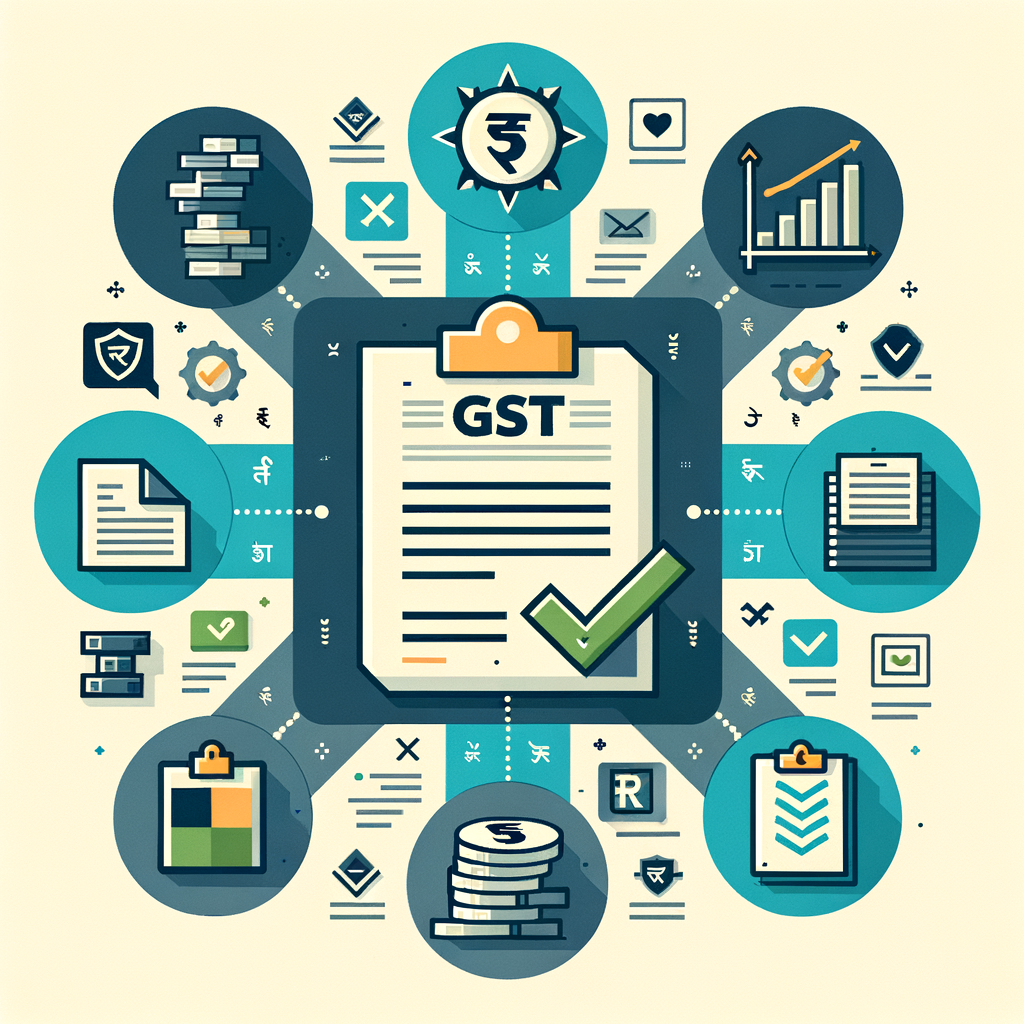Understanding GST Compliance: An Overview for Businesses
As a business owner, you wear many hats. You’re the CEO, the head of marketing, the chief of operations, and often, the entire HR department. But is ‘tax expert’ one you’re comfortable with? Navigating the complexities of the Goods and Services Tax (GST) can feel daunting, but it doesn’t have to be. This comprehensive GST compliance overview is designed to demystify the process for you. GST is the single, indirect tax that has streamlined India’s tax structure, impacting every stage from manufacturing to final consumption. Its successful implementation hinges on businesses like yours staying compliant. This guide will provide a clear and simple roadmap, helping you understand your obligations and avoid common pitfalls. Whether you are a small business owner, a startup founder, or even a salaried individual with a growing side hustle, this guide is for you.
What is GST Compliance? A Foundational Guide for Businesses
Embarking on your business journey requires a solid grasp of your tax responsibilities, and at the heart of it lies a clear understanding of GST compliance for businesses. It is a common misconception that compliance is merely about paying the final tax amount on time. In reality, it is a continuous cycle of activities that ensures your business operates within the legal framework defined by the GST laws. This involves everything from the initial registration step to the meticulous maintenance of records for future audits. Neglecting any part of this cycle can lead to a domino effect of penalties, loss of tax credits, and significant business disruptions. Therefore, viewing compliance not as a burden but as an integral part of your business strategy is the first step towards financial health and sustainable growth in the competitive Indian market.
More Than Just Paying Taxes
GST compliance is the complete set of activities that a registered taxpayer must perform to adhere to the GST Act. It’s an end-to-end process that ensures transparency and accountability in the tax system.
The core activities include:
- Obtaining GST Registration: Correctly identifying your need to register and completing the application process is the starting point.
- Issuing GST-Compliant Invoices: Every sale must be documented with a proper tax invoice that contains all mandatory details. This is the foundational document for the entire GST system.
- Filing Accurate GST Returns on Time: Regularly reporting your sales, purchases, and tax liability through various forms like GSTR-1 and GSTR-3B is a non-negotiable monthly or quarterly activity.
- Paying GST Dues: Ensuring that the calculated tax liability is paid to the government before the specified due date.
- Maintaining Proper Records and Books of Accounts: Keeping detailed records of all transactions, including invoices, debit/credit notes, and stock registers, is legally required and essential for claiming credits and facing audits.
The Three Pillars of GST: CGST, SGST, and IGST
To navigate GST effectively, you must understand its three main components. The type of tax levied depends entirely on whether the transaction is within a state (intra-state) or between states (inter-state).
| Tax Component | Full Form | When It Applies | Example |
|---|---|---|---|
| CGST | Central Goods and Services Tax | On intra-state (within the same state) supplies | A laptop sold from Mumbai to a buyer in Pune. GST is split into CGST (to Central Govt) and SGST (to Maharashtra Govt). |
| SGST | State Goods and Services Tax | On intra-state (within the same state) supplies | Same example as above. |
| IGST | Integrated Goods and Services Tax | On inter-state (between two different states) supplies and on imports/exports | A software service provided by a company in Delhi to a client in Bengaluru. The entire GST is levied as IGST (to Central Govt). |
Why Staying Compliant is a Business Superpower
Adhering to GST regulations is not just about avoiding trouble; it’s a strategic advantage that can significantly boost your business. When you are fully compliant, you unlock several benefits that contribute directly to your bottom line and market reputation. It transforms a perceived obligation into a powerful tool for growth and stability.
- Seamless Claim of Input Tax Credit (ITC): Proper compliance is the key to unlocking ITC. This means you can reduce your tax liability by claiming credit for the GST you’ve already paid on your business purchases, effectively lowering your operational costs.
- Avoidance of Heavy Penalties and Legal Issues: Non-compliance comes with a steep price, including hefty late fees, interest on unpaid taxes, and potential legal proceedings that can drain your resources and tarnish your reputation.
- Enhanced Credibility with Customers and Suppliers: A valid GSTIN and a history of timely compliance signal that your business is legitimate, professional, and trustworthy. This builds confidence among your partners and large B2B clients.
- Easier Access to Loans and Business Credit: Financial institutions often scrutinize your GST filing history as a measure of your business’s financial health and discipline. A clean compliance record can significantly improve your chances of securing loans and other forms of credit for expansion.
The Essential GST Compliance Checklist for Indian Businesses
To simplify the process, we have created an actionable GST compliance checklist India that breaks down your key responsibilities into manageable steps. Following this checklist will help you stay organized and ensure you cover all your bases, from the moment you start your business to your day-to-day operations. This systematic approach helps prevent costly oversights and builds a strong foundation of financial discipline within your organization. Think of it as your step-by-step guide to navigating the regulatory landscape with confidence and precision.
Step 1: GST Registration
The first step in your compliance journey is getting registered under GST, if applicable. Registration is mandatory for businesses whose aggregate turnover exceeds the prescribed threshold limits. For businesses supplying goods, the threshold is typically ₹40 lakhs, and for those providing services, it is ₹20 lakhs (these limits can be lower for certain special category states). However, some businesses must register irrespective of their turnover. For new ventures, Mastering GST Registration in India is a critical milestone. This includes e-commerce sellers operating on platforms like Amazon or Flipkart, businesses making inter-state sales, and those liable to pay tax under the reverse charge mechanism.
- Actionable Tip: You can complete the entire registration process online. Visit the official government GST Portal to begin your application.
Step 2: Issuing GST-Compliant Invoices
Your invoice is the most critical document in the GST ecosystem. It is the primary evidence of a transaction and the basis for the recipient’s claim of Input Tax Credit. A GST-compliant tax invoice must contain several mandatory fields to be considered valid. These include the GSTIN of both the supplier and the recipient, a unique invoice number and date, HSN/SAC codes for goods/services, a clear description of goods/services, quantity, taxable value, and the applicable GST rates and amounts broken down into CGST, SGST, or IGST. For businesses with a turnover exceeding a certain limit, e-invoicing is also mandatory, where invoices must be electronically authenticated on the government’s Invoice Registration Portal (IRP).
Step 3: Timely Filing of GST Returns
Filing GST returns is a mandatory activity for all registered taxpayers, even if there are no transactions during a tax period (a ‘Nil’ return must be filed). A detailed guide on How to File GST Returns Online can walk you through the entire process. The two most common and crucial returns for small businesses are:
- GSTR-1: This is the return where you declare the details of all your outward supplies (sales). It is typically due by the 11th of the following month.
- GSTR-3B: This is a summary return where you declare your total sales, purchases, and Input Tax Credit, and make the final tax payment. It is generally due by the 20th of the following month.
Missing these deadlines leads to penalties and can prevent your customers from claiming their ITC, potentially damaging your business relationships.
Step 4: Accurate Record-Keeping
The GST law mandates that every registered person must maintain proper and accurate records of their business transactions at their principal place of business. This is not just good business practice; it’s a legal requirement essential for audits and assessments. The records you must maintain include your sales and purchase registers, stock records detailing opening balance, receipts, supplies, and closing balance, records of Input Tax Credit availed, output tax payable and paid, and any other documents like invoices, bills of supply, credit notes, and debit notes. As per the GST law, these records must be retained for a period of 72 months (6 years) from the due date of filing the annual return for that year.
Common GST Compliance Issues in India (And How to Solve Them)
Even with the best intentions, businesses can face challenges. Understanding the common GST compliance issues in India is the first step toward proactively avoiding them. These issues often arise from simple clerical errors, a lack of communication with suppliers, or a misunderstanding of the complex GST rules. Addressing them swiftly is crucial, as unresolved discrepancies can block your cash flow, invite scrutiny from tax authorities, and lead to significant financial repercussions. Here, we break down the most frequent problems and provide clear, practical solutions to keep your business on the right track.
Problem: Invoice Mismatches (GSTR-1 vs. GSTR-2B)
- Explanation: One of the most significant challenges is the mismatch between your purchase records and the data reflected in your GSTR-2B (an auto-drafted ITC statement). This happens when your supplier either fails to file their GSTR-1, files it late, or enters your invoice details incorrectly (e.g., wrong GSTIN, wrong invoice value). A mismatch directly blocks your ability to claim Input Tax Credit on that purchase, impacting your working capital.
- Solution: Make reconciliation a monthly habit. Before filing your GSTR-3B, download your GSTR-2B from the GST portal and systematically compare it with your own purchase register. Use accounting software to automate this matching process. In case of any discrepancies, communicate immediately with your supplier and request them to amend their GSTR-1 in the next filing period.
Problem: Late Filing and Non-Payment
- Explanation: Procrastination or oversight can lead to missing the due dates for filing GSTR-1 and GSTR-3B. The consequences are immediate and twofold: you are charged a late filing fee for each day of delay, and interest is levied on the amount of tax that was not paid on time. These charges can accumulate rapidly, turning a small tax liability into a substantial financial burden.
- Solution: Discipline is key. Set up calendar reminders or alarms for the 11th and 20th of every month. Better yet, consider using a compliance service or software that sends automated reminders and can handle filings on your behalf. Always aim to file a few days before the deadline to account for any last-minute technical glitches on the portal.
Problem: Incorrectly Claiming Input Tax Credit (ITC)
- Explanation: The rules surrounding ITC can be tricky. A common error is claiming ITC on items that are specifically blocked or ineligible under GST law. These include expenses like food and beverages, club memberships, and goods or services used for personal consumption. Another frequent mistake is claiming ITC without being in possession of a valid tax invoice or before actually receiving the goods or services.
- Solution: Educate yourself and your accounting team on the specific provisions of Section 17(5) of the CGST Act, which lists the Blocked Credits Under Section 17(5). Always ensure you have a GST-compliant invoice for every purchase before you claim ITC. Maintain a clear distinction between business and personal expenses. When in doubt about the eligibility of a particular expense, it is always wise to consult with a tax professional.
Your Simplified GST Compliance Guide for Indian Businesses
Mastering GST is a journey, not a destination. To help you navigate it successfully, this final section consolidates our advice into a simplified GST compliance guide for Indian businesses. These are high-level strategies that, when implemented, create a robust framework for managing your tax obligations efficiently. By combining technology, continuous learning, and expert support, you can transform compliance from a complex chore into a streamlined process that supports your business’s growth and protects it from unnecessary risks. This proactive approach will save you time, money, and stress in the long run.
Leverage Technology for Accuracy
In today’s digital age, managing GST manually is inefficient and prone to errors. Invest in a good accounting or billing software that is GST-enabled. These tools are designed to automate many of the tedious compliance tasks. They can generate GST-compliant invoices with the correct HSN/SAC codes, maintain digital records of all your transactions, help in reconciling your purchases with GSTR-2B, and generate accurate reports needed for filing GSTR-1 and GSTR-3B at the click of a button. This reduces the chance of human error and frees up your valuable time to focus on core business activities.
Stay Informed and Updated
The world of GST is not static; rules, rates, and procedures are subject to change. The GST Council meets periodically, and their decisions can lead to amendments in the law. It is crucial for business owners to stay abreast of these developments to ensure they remain compliant. Make it a practice to follow official and reliable sources for information. Relying on hearsay or outdated articles can lead to costly mistakes.
- Actionable Tip: Bookmark the official website of the Central Board of Indirect Taxes and Customs (CBIC) and check it regularly for the latest notifications, circulars, and press releases.
Know When to Call an Expert
As your business grows, its transactions become more complex. You might start dealing with exports, special economic zones (SEZs), or complex service agreements, each with its own set of GST implications. While handling basic compliance yourself might be feasible in the beginning, there comes a point where the risk of making an error outweighs the cost of professional help. A chartered accountant or a specialized tax consulting firm can provide expert guidance, ensure 100% accuracy in your filings, represent you during assessments, and offer strategic advice on tax planning. Their expertise is an investment in your company’s financial security.
Conclusion
Navigating the GST landscape is an essential skill for any Indian business owner. The key pillars of compliance—correct registration, proper invoicing, timely filing, and meticulous record-keeping—form the bedrock of a healthy and legally sound enterprise. This GST compliance overview demonstrates that while the rules may seem complex, a systematic and informed approach can simplify the process significantly. Staying compliant is not just a legal obligation; it is a strategic business advantage that enhances your credibility, secures your cash flow through timely ITC, and protects you from unforeseen financial shocks. It allows you to build your business on a foundation of trust and stability.
Feeling overwhelmed by GST? Don’t let compliance complexities slow your growth. The experts at TaxRobo are here to manage your GST filings, so you can focus on what you do best. Contact us today for a free consultation!
Frequently Asked Questions (FAQs)
1. What is the penalty for not filing GST returns on time?
The penalty for late filing has two components. First, there is a fixed late fee, which is typically ₹50 per day of delay (₹20 for Nil returns) for each return (CGST and SGST), subject to a maximum cap based on turnover. Second, if you have a tax liability, you must pay interest at 18% per annum on the outstanding tax amount for the period of delay.
2. Do I need GST registration if I only sell services online?
The requirement for GST registration for service providers is based on turnover. You need to register if your aggregate annual turnover exceeds ₹20 lakhs (₹10 lakhs for special category states). However, if you sell your services through an e-commerce operator (like Urban Company), you are required to register for GST mandatorily, regardless of your turnover.
3. What is an HSN code and why is it important?
HSN stands for Harmonized System of Nomenclature. It is an internationally recognized system of classifying goods. In the context of GST, every product has a specific HSN code. This code is important because it helps in systematically identifying goods and determining the correct GST rate applicable to them. Quoting the correct HSN code on your invoices is a mandatory part of GST compliance and ensures accurate tax calculation and reporting. A similar system for services is called SAC (Service Accounting Code).
4. Can I correct a mistake made in a previously filed GST return?
The GST portal does not allow you to revise a return that has already been filed. However, the system provides a mechanism to make corrections. If you have made a mistake in your GSTR-1 or GSTR-3B (e.g., under-reported sales or claimed excess ITC), you can rectify it by making amendments or adjustments in the GSTR-1 and GSTR-3B of a subsequent month. For significant errors or complex situations, it is highly recommended to consult a tax professional to ensure the correction is made properly.



